NVIDIA GeForce GTX 670 Review Feat. EVGA: Bringing GK104 Down To $400
by Ryan Smith on May 10, 2012 9:00 AM ESTCompute
Shifting gears, as always our final set of benchmarks is a look at compute performance. As we have seen with GTX 680, GK104 appears to be significantly less balanced between rendering and compute performance than GF110 or GF114 were, and as a result compute performance suffers. Cache and register file pressure in particular seem to give GK104 grief, which means that GK104 can still do well in certain scenarios, but falls well short in others.
Our first compute benchmark comes from Civilization V, which uses DirectCompute to decompress textures on the fly. Civ V includes a sub-benchmark that exclusively tests the speed of their texture decompression algorithm by repeatedly decompressing the textures required for one of the game’s leader scenes. Note that this is a DX11 DirectCompute benchmark.
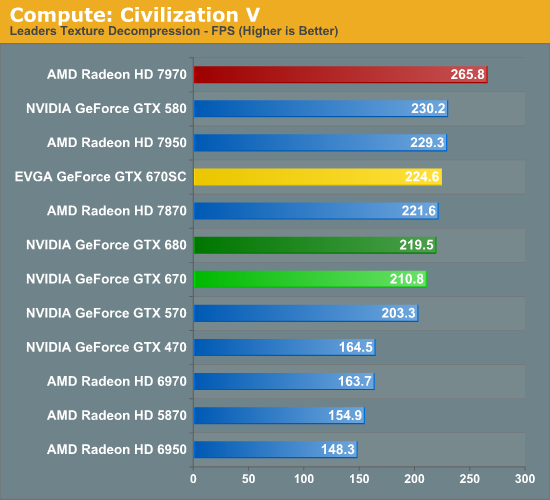
It’s quite shocking to see the GTX 670 do so well here. For sure it’s struggling relative to the Radeon HD 7900 series and the GTX 500 series, but compared to the GTX 680 it’s only trailing by 4%. This is a test that should cause the gap between the two cards to open up due to the lack of shader performance, but clearly that this not the case. Perhaps we’ve been underestimating the memory bandwidth needs of this test? If that’s the case, given AMD’s significant memory bandwidth advantage it certainly helps to cement the 7970’s lead.
Our next benchmark is SmallLuxGPU, the GPU ray tracing branch of the open source LuxRender renderer. We’re now using a development build from the version 2.0 branch, and we’ve moved on to a more complex scene that hopefully will provide a greater challenge to our GPUs.
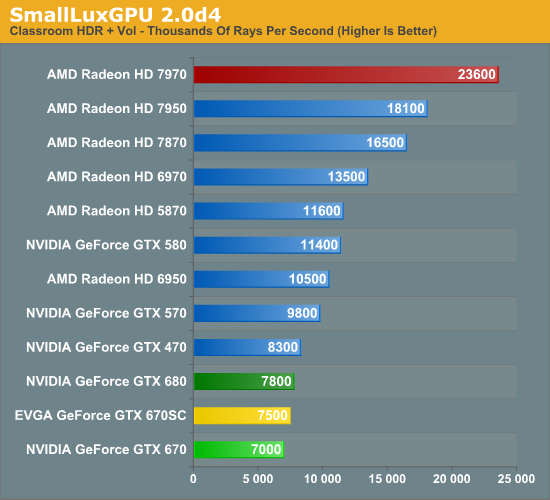
SmallLuxGPU on the other hand finally shows us that larger gap we’ve been expecting between the GTX 670 and GTX 680. The GTX 680’s larger number of SMXes and higher clockspeed cause the GTX 670 to fall behind by 10%, performing worse than the GTX 570 or even the GTX 470. More so than any other test, this is the test that drives home the point that GK104 isn’t a strong compute GPU while AMD offers nothing short of incredible compute performance.
For our next benchmark we’re looking at AESEncryptDecrypt, an OpenCL AES encryption routine that AES encrypts/decrypts an 8K x 8K pixel square image file. The results of this benchmark are the average time to encrypt the image over a number of iterations of the AES cypher.
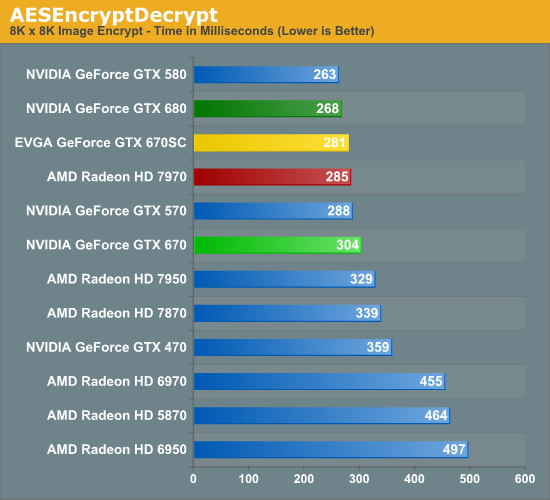
Once again the GTX 670 has a weak showing here, although not as bad as with SmallLuxGPU. Still, it’s enough to fall behind the GTX 570; but at least it’s enough to beat the 7950. Clockspeeds help as showcased by the EVGA GTX 670SC but nothing really makes up for the missing SMX.
Our foruth benchmark is once again looking at compute shader performance, this time through the Fluid simulation sample in the DirectX SDK. This program simulates the motion and interactions of a 16k particle fluid using a compute shader, with a choice of several different algorithms. In this case we’re using an (O)n^2 nearest neighbor method that is optimized by using shared memory to cache data.
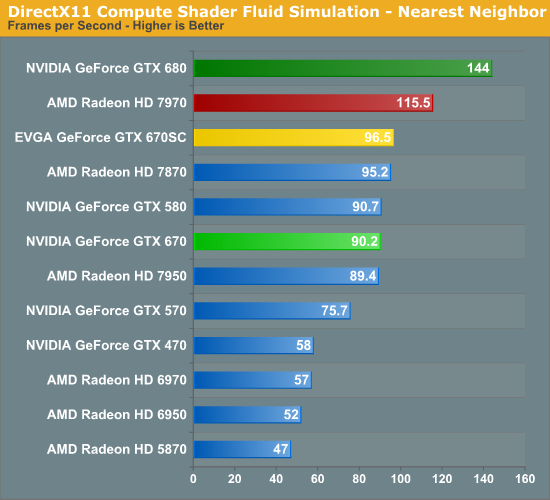
For reasons we’ve yet to determine, this benchmark strongly dislikes GTX 670 in particular. There doesn’t seem to be a performance regression in NVIDIA’s drivers, and there’s not an incredible gap due to TDP, it just struggles on the GTX 670. As a result performance of the GTC 670 only hits 42% of the GTX 680, which is well below what the GTX 670 should theoretically be getting. Barring some kind of esoteric reaction between this program and the unbalanced GPC a driver issue is still the most likely culprit, but it looks to only affect the GTX 670.
Finally, we’re adding one last benchmark to our compute run. NVIDIA and the Folding@Home group have sent over a benchmarkable version of the client with preliminary optimizations for GK104. Folding@Home and similar initiatives are still one of the most popular consumer compute workloads, so it’s something NVIDIA wants their GPUs to do well at.
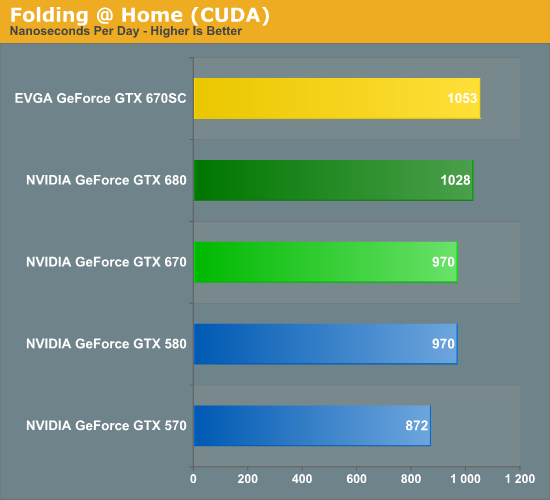
Whenever NVIDIA sends over a benchmark you can expect they have good reason to, and this is certainly the case for Folding@Home. GK104 is still a slouch given its resources compared to GF110, but at least it can surpass the GTX 580. At 970 nanoseconds per day the GTX 670 can tie the GTX 580, while the GTX 680 can pull ahead by 6%. Interestingly this benchmark appears to be far more constrained by clockspeed than the number of shaders, as the EVGA GTX 670SC outperforms the GTX 680 thanks to its 1188MHz boost clock, which it manages to stick to the entire time.










414 Comments
View All Comments
CeriseCogburn - Friday, May 11, 2012 - link
Wasn't caught ? LOL Sounds correct, at least in your mind.Problem is when amd is caught red handed, none of you amd fanboys have a clue about it, ever.
Now I don't have anything against AMD, it's just clear the truth should be told, as I said let's apply the amd fanboy talking points equally, let's do a real analysis and not with instant amnesia that favors amd or ignores the current facts like egg sales.
I have noticed you amd fans have a real hatred for nVidia and all say a similar thing as you just did. It's like poor loser syndrome but I don't think any of you are faking it, I think you are living it in your minds.
That's really sad.
I do believe that's why you can so blindly deny facts and are so often excuse makers and liars for amd and against nVidia quite unfairly. Cut out the hate man. nVidia isn't somehow worse than amd, nor vise versa.
Now I assure you, my post you went into attack mode over above is very simply my on the fly instant analysis by assembling the known facts. It includes principles like what's good for the goose is also fair on the gander, and very simple logic, and some actual original thoughts, etc.
My apologies that I am so excessively astute and can easily see though the amd fud monkey tp, and worse yet, right, show easily the actual nVidia advantage in that very area.
I'm gifted.
SlyNine - Saturday, May 12, 2012 - link
The GTX680 has out sold the 78xx line, interesting, but you need to prove it.CeriseCogburn - Saturday, May 12, 2012 - link
Go to new egg and click on the best selling EVGA GTX680, go to the reviews tab, click the verified buys checkmark, and read the number of verified buyers of the total commenters.That gives you a fair estimate that will be about the same as fair estimates for other products ( it eliminates counting spammers who just have to post without purchasing ).
So just go do that also for the 7870 and 7850 and add up all the totals, and of course include on the 7870 and 7850 and out of stock cards, the "up to 5 eggs" reviews are available for out of stock...
Compare your totals, if you don't know how to navigate new egg efficiently the tip you need is use the "Guided Results" tab on the upper left area once you have clicked into "Desktop Graphics Hardware" from the "shop all stores" yellow upper left start button.
So anyway, 680 was 108 verified a few days ago and all the 7870 and 7850 combined in total were below that by like 30 something - only a single 680 sku was needed, making it easier to collate in the nVidia side.
It should take you all of 3 minutes to verify this right now, and given the level of competence in this post area, here's some helpful starts
http://www.newegg.com/Product/Product.aspx?Item=N8...
680 single sku up to 111 now up from 108
78xx series link access below
http://www.newegg.com/Product/ProductList.aspx?Sub...
There you are, the proof you demanded, once again delivered.
SlyNine - Saturday, May 12, 2012 - link
So that's you're premise for total sales, how many verified buyers there are on neweggs REVIEWS. That's one hella questionable premise and invalid inference of the data available.lmao. Epic fail. Take a logic class
CeriseCogburn - Sunday, May 13, 2012 - link
Yes whine about the data set all you want, but we also have reviewer commentary that is confirming in this, with zero counters by you and yours.Newegg is actually quite an accurate machine for such a thing, best price, best known, most used, and has shown accuracy for a long time in this manner.
Foreigners (non USA) may argue but we don't see any counter arguments now do we mr sad 5870 ? :)
MrSpadge - Thursday, May 10, 2012 - link
You should compare to HD7950 or HD7970 instead of HD6970.. otherwise it's a no brainer ;)chizow - Thursday, May 10, 2012 - link
Certainly a better effort from Nvidia but the premiums are still a product of AMD's overpriced 28nm parts.If AMD priced as they should've from the outset based on historical pricing and relative performance to 40nm parts, we would've seen:
7970 @ $380
7950 @ $300
and Nvidia's parts would've fallen into place accordingly as well:
680 @ $400-$420
670 @ $350
GK110/685 @ $500-$550
GTX 690 @ $700-800
I guess we can't fault Nvidia too much though. In the end they can't keep GK104 in stock anywhere and they still manage to beat AMD convincingly in both price and performance.
The consumer is the one that loses however, paying high premiums for the smallest increase in performance for a full generational/process node improvement.
XZerg - Thursday, May 10, 2012 - link
The price gauging is always a product when the underdog in a market (not necessarily in performance) outdoes the big boss. We saw this happen back when AMD brought out the A64 as well or when ATI released R300 chip. So from consumer's $$$ point of view underdog should stay underdog but deliver performance that matches the big boss.JlHADJOE - Thursday, May 10, 2012 - link
G92 baby!90% of 8800GTX performance at less than half the price.
It was so good, it actually stayed competitive through 3 or 4 product cycles (albeit getting a new sticker every time).
CeriseCogburn - Thursday, May 10, 2012 - link
That's a failed analysis since the price gouging by the same complainers is always present on the flagship models.The true analysis is the honest and common sense one. No matter what anyone's twisted brain calls the competers, when any one in competition throws up a leader board item, they charge for it.
What's shameful in amd's case is the very quick slap down they experienced - smacking $579.99 down to $449.99(or 479) then the second whallop sending them to the deck, the 3 games they offered to attempt to keep interest going, and now another knockout punch square to the drooling amd choppers as they wobbled on noodle legs still getting the former ten count - the GTX670 tag team card with the new smack down....
I suspect amd will try to maintain some sort of composure and self esteem this time by not budging as long as they possibly can... because it's embarrassing already and now the GTX670 has turned amd from bright pink to their standard red color - flush to the point of passing out.
Yes, amd will pretend now - pretend it doesn't have to drop prices again.